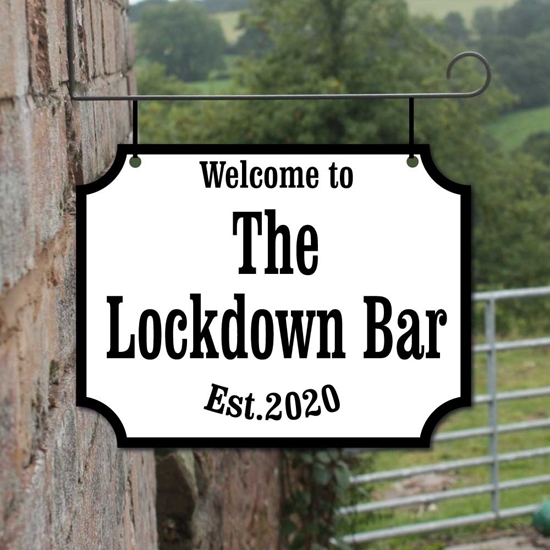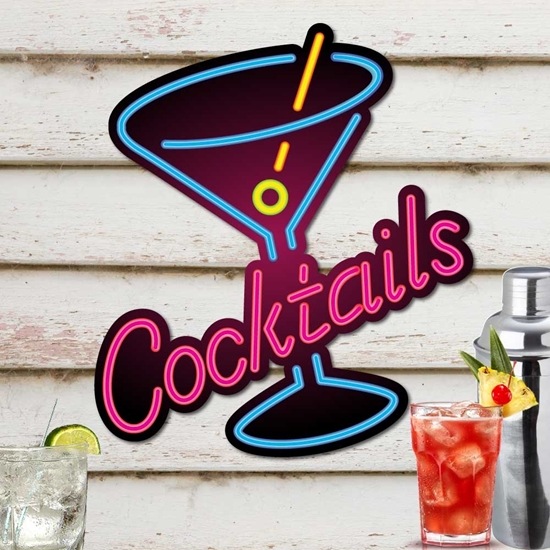Good Facts On Picking Bar Signs
Wiki Article
What Are The Various Purposes Of Bar Signs?
Bar signs can be used for a myriad of reasons. Here are a few of the primary functions of bar signage and their differences: 1. Branding
The purpose of this logo is To help strengthen and grow the bar brand.
Features: Display the bar's logo, name and signature colors. It is designed to be an important element that represents the overall theme and vibe of the establishment.
Example: Neon signs featuring the logo of the bar or custom-designed metal signs that bears the bar's name.
2. Information
Goal: To give patrons essential information about the bar.
Features: Clear, easy-to read text that communicates vital information such as operating hours Wi-Fi passwords, hours of operation, home rules, or bathroom areas.
Signs that indicate restrooms or show hours of operations on walls near entrances are examples.
3. There are also Decorative items on the Decorative
Goal: To enhance the appearance of the bar.
Highlights: The decor of the bar is often more artistic, or themed. Text or specific information may not be included.
Some examples: vintage advertisements for beer, humorous or fun signs, themed artwork.
4. Promotional Materials
The purpose of the campaign is To advertise certain products, specials or other events.
Features Eye-catching designs and emphasize special events, new menu items or new menu items. Some elements are temporary or changeable.
Examples: Chalkboards featuring daily deals, banners advertising happy hour deals posters to advertise upcoming events.
5. Directional
Patrons who are guides in the bar.
Features: Arrows that are clear for patrons to follow, e.g. finding restrooms exits, restrooms, and other areas of the bar.
Examples: Arrows for direction within different seating locations.
6. Regulatory/Compliance
Purposes: To comply with all legal requirements as well as to assure safety.
Features: Necessary signs that fulfill legal obligations like warning of smoking zones, maximum occupancy limits, or emergency exits.
For example, "No Smoking", "Occupancy Limit" and "Emergency Exit" signs.
7. Interactive
The goal of the project is to get customers involved in an interactive experience.
Features: Tools to increase patron participation. Examples include write-on surface as well as digital interaction.
Signs with QR codes that provide links to menus in digital format, social media sites or other sources of information.
8. Thematic
The purpose is to create a specific theme or atmosphere.
Features: Signs aligned with the design of the bar, which adds to the overall ambience.
Examples: Pirate-themed signs in a nautical bar and rustic wooden signs at a country-themed bar.
9. Menu
The purpose of this menu is to showcase the drinks available in the bar.
Features: Clear list of beverages and food and beverages, often with prices. Can be either fixed or modifyable.
Examples: Digital screens that display rotating menu items, wall-mounted drink menus.
Each bar sign is created for a specific reason. Its design is determined by the function it plays within the bar. Bar owners who know the distinctions between them can put up signs that improve their customers' experience and meet their operational requirements. Take a look at the most popular moved here for more tips including personalised hanging pub signs, hanging pub signs for sale, personalised garden bar signs, small pub signs, large personalised bar signs, personalised hanging bar sign, hanging pub signs personalised, bar signs for home bar, indoor bar signs, pub bar signs for sale and more.

What Is The Difference Between Bar Signs In Terms Of Customisation And Personalisation?
Bar signs can be found in a wide range of styles and customization options that reflect the individual brand, design and ambience of each company. What are the differences in bar signs when it comes to individualization and customization? Material
Customizable Materials: Wood, metal Acrylic, neon chalkboard, LED, vinyl.
Personalization: Use materials that match the theme and aesthetic of the bar for example, wooden furniture in a comfortable bar, or contemporary acrylic in a club.
2. Design
Custom Graphics Illustrations, typography, and artwork.
Personalization: Utilize branding elements, unique images to the bar, as well as thematic designs that reflect its identity.
3. Size and Shape
Custom Sizes: from small outdoor marquees, to huge tabletop signs.
Personalization: You can customize the size and shape to fit specific areas and to satisfy brand requirements. For example, larger lettering can be used for a striking statement piece. Small signs are ideal for smaller areas.
4. Color
Custom Color Schemes: Pantone matching, RGB options, and custom colors.
Personalization: Choose colors that resonate with the bar's identity design, interior decor, and target audience preferences, whether vibrant and bold or subdued and elegant.
5. Lighting
Custom Lighting Effects Neon LED backlit edge-lit projections or other.
Personalization: Select lighting that will enhance the mood, ambience and visibility while also enhancing the overall look of the bar. For instance, select neon or LED lighting for a modern feel.
6. Text Messaging
Custom Text: Bar name, slogans, quotes, menu items, event announcements.
Personalization - Create messaging that resonates with patrons. It must reflect the personality of the bar and clearly explain any specials, promotions or the values.
7. Interactivity
Custom Interactive Features such as QR Codes, digital displays, or interactive projections.
Personalization: Include interactive elements that draw patrons, encourage participation, and provide memorable experiences, for example, interactive menu boards and digital menus, as well as games.
8. Installation and Mounting
Custom Options for Mounting: Wall-mounted, hanging, freestanding mounting or window mounted mounting.
Personalization - Choose mounting options to enhance the bar's layout, enhance visibility, and seamlessly integrate with the overall design.
9. Seasonal and Event-Specific
Custom Themes: Christmas decorations, seasonal themes, or themed events.
Personalization - Update signs frequently to reflect seasonal changes, mark holidays, advertise special events, or make a lively and stimulating environment for patrons.
10. Brand Consistency
Logos, fonts and colors are all branding elements that can be customized.
Personalization: Be consistent with the signage and other brand materials to help build brand recognition, reinforce your brand recognition and create an enjoyable and memorable experience for customers.
The Benefits of Customization & Personalization
Brand Differentiation: Make yourself stand out and leave a lasting impression.
Brand Identity: Enhance the brand's image by encouraging customer loyalty.
Atmosphere Enhancement: Match signage with the bar's ambience and desired atmosphere, improving the overall customer experience.
Engagement: Signage that is personalized can spark conversations, increase excitement, and stimulate patron interaction.
By leveraging customization and personalization choices, bar proprietors are able to make unique and effective signage that not only conveys information effectively, but can also enhance the overall design, aesthetics, and branding of their establishment. Read the top rated personalised bar signs examples for website tips including bar hanging sign, personalised home pub sign, personalised beer sign, pub signs for garden, novelty bar signs, personalised hanging pub signs, home made bar sign, novelty bar signs, personalised home bar signs, personalised hanging bar sign and more.

How Do Bar Signs Differ In Terms Of Maintenance?
Here are some of the ways bar signs can differ in the maintenance requirements they require. Here's how bar sign signs differ in terms of maintenance requirements: 1. Material
Metal Signs require very little maintenance. Cleaning may be required to clean dust or dirt.
Wooden Signs (Signs) They require regular inspections for signs of warping or rot. Regular staining is required to maintain their appearance and durability.
Acrylic signs: easy to clean using mild soap and water. It is resistant to the most scratching and chemicals.
Neon/LED sign requires regular bulb replacement and inspection of electrical components.
2. Lighting
Non-Illuminated Signals: They are typically low maintenance. An occasional clean may be required to get rid of dirt or dust.
Illuminated signs (Neon/LED). This requires regular inspection and cleaning of light components such as bulbs or LED modules to ensure that they are bright.
3. Location
Indoor signs: They require less maintenance than outdoor signs because they are not exposed the elements.
Outdoor signs require more frequent maintenance because of the exposed to UV radiation, the weather and changes in temperature. To ensure that your sign isn't damaged it is possible to carry out regular inspections, cleaning, and then apply protective coatings.
4. Design Complexity
Simple Signs - Designs that have smaller elements need less maintenance as compared to elaborate or intricate designs that have greater areas susceptible to dirt accumulation or damage.
Digital Signs: They require updates to software, changes to content as well as periodic maintenance to ensure correct functionality and performance.
5. Mounting & Installation
Securing Installation: Signs correctly mounted are less likely to require maintenance over time because of their movement or falling off.
Signs with poor mounting: Signs that have been poorly mounted or are installed improperly may require frequent maintenance due to problems like sagging, inclining or removal.
6. Environmental Factors
Weather Exposure: Signs that are located in areas with excessive humidity, rain or extreme temperatures could require more frequent maintenance to avoid corrosion discoloration, or other forms of degradation.
Pollution and debris: Signs in industrial or urban areas are more likely build up dust, dirt or pollutants. This requires regular cleaning for visibility.
7. Customization
Custom-designed signs: Signs with intricate designs, unique features, or customized finishes may require specialized care to ensure their function and appearance.
8. Frequency
Regular maintenance: A routine of regular cleaning maintenance, inspections and cleaning will assist in preventing minor problems from becoming major ones and keep signs in top state.
Maintenance as required: Signs will require additional maintenance to address issues like damages and malfunctions or wear.
A proper maintenance program is beneficial.
Extended Lifespan: Regularly scheduled maintenance helps prolong the lifespan of signs, reducing the requirement for replacements that are premature.
High Performance: Signs that are well-maintained ensure their readability, visibility and effectiveness in communicating messages to customers.
Cost Savings: Regular maintenance can help avoid expensive repairs or replacements down the line, which can save money in the long run.
Bar owners who know the maintenance needs of the various styles and types of bar signs should implement an action plan to make sure their signage is attractive and functional. It also improves the efficiency of their bar and enhances the overall experience of customers. Have a look at the top rated bar signs for home for blog tips including personalised hanging pub signs, personalised signs for home bar, bar sign outdoor, staying inn sign, pub signs to buy, staying inn sign, cocktail bar sign, personalised hanging pub signs, bar hanging sign, bar wall signs and more.
